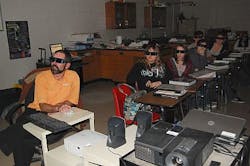Holly Ridge, NC--Dixon High School in North Carolina recently purchased XPAND 3D Education kits to provide a more engaging learning experience for its students in subjects such as biology, where 3D content offers greater depth and detail. The kits include XPAND DLP-Link 3D Glasses (which work with all 3D-ready DLP projectors) and a library full of educational 3D content for many subjects.
Jason Chambers, a Biology teacher at the high school, started using the 3D material in October 2011. He has employed XPAND’s 3D content, including Designmate 3D technology, in almost all of his instruction, whether it is an introduction before diving into a new subject, teaching the subject itself, or even as a refresher after a section is completed. In General Biology alone, there has been a more than 50 percent improvement in test scores, he says.
In North Carolina, a student has to score a level 3 (mastery of concepts) or 4 (superior understanding and clearly proficient in concept) on a statewide testing exam to be considered efficient. All classes taught by Chambers received 100 percent proficiency using the 3D material. What's more, an honors class he taught using the material had 12 students score 4 in a class of 21 students.
All the videos in the kit are under 10 minutes long, so they add value to Chambers' lesson plans rather than taking it away, he says. He also notes that the 3D content is ideal for subjects like biology, where 3D content showing DNA, mitosis, or cell division can help explain the concept better than a 2D picture.
The kit's active-shutter 3D technology is enjoyable to the students even more so than the passive 3D they see in the movie theater, says Chambers. "They recognize the difference of the active technology that XPAND 3D uses and how it eliminates strain on the eyes and headaches. I explain the differences in the technology to them and show how the light enters the eyes differently. It’s a lesson within itself," he says.
For more information on XPAND 3D Education, please visit http://www.xpand.me/education.
